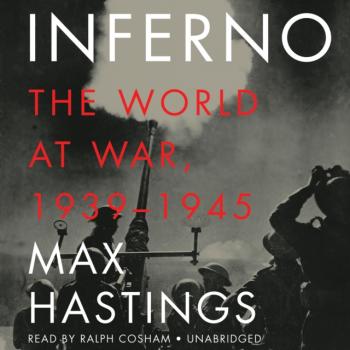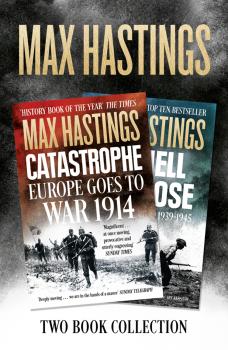ТОП просматриваемых книг сайта:
Max Hastings
Список книг автора Max HastingsАннотация
THE SUNDAY TIMES BESTSELLER‘His masterpiece’ Antony Beevor, Spectator‘A masterful performance’ Sunday Times‘By far the best book on the Vietnam War’ Gerald Degroot, The Times, Book of the YearVietnam became the Western world’s most divisive modern conflict, precipitating a battlefield humiliation for France in 1954, then a vastly greater one for the United States in 1975. Max Hastings has spent the past three years interviewing scores of participants on both sides, as well as researching a multitude of American and Vietnamese documents and memoirs, to create an epic narrative of an epic struggle. He portrays the set pieces of Dienbienphu, the Tet offensive, the air blitz of North Vietnam, and less familiar battles such as the bloodbath at Daido, where a US Marine battalion was almost wiped out, together with extraordinary recollections of Ho Chi Minh’s warriors. Here are the vivid realities of strife amid jungle and paddies that killed 2 million people.Many writers treat the war as a US tragedy, yet Hastings sees it as overwhelmingly that of the Vietnamese people, of whom forty died for every American. US blunders and atrocities were matched by those committed by their enemies. While all the world has seen the image of a screaming, naked girl seared by napalm, it forgets countless eviscerations, beheadings and murders carried out by the communists. The people of both former Vietnams paid a bitter price for the Northerners’ victory in privation and oppression. Here is testimony from Vietcong guerrillas, Southern paratroopers, Saigon bargirls and Hanoi students alongside that of infantrymen from South Dakota, Marines from North Carolina, Huey pilots from Arkansas.No past volume has blended a political and military narrative of the entire conflict with heart-stopping personal experiences, in the fashion that Max Hastings’ readers know so well. The author suggests that neither side deserved to win this struggle with so many lessons for the 21st century about the misuse of military might to confront intractable political and cultural challenges. He marshals testimony from warlords and peasants, statesmen and soldiers, to create an extraordinary record.
Аннотация
A masterly history of the Dambusters raid from bestselling and critically acclaimed Max Hastings.Operation Chastise, the overnight destruction of the Möhne and Eder dams in north-west Germany by the RAF’s 617 Squadron, was an epic that has passed into Britain’s national legend.Max Hastings grew up embracing the story, the classic 1955 movie and the memory of Guy Gibson, the 24-year-old wing-commander who won the VC leading the raid. In the 21st Century, however, Hastings urges that we should review the Dambusters in much more complex shades. The aircrew’s heroism was wholly authentic, as was the brilliance of Barnes Wallis, who invented the ‘bouncing bombs’. But commanders who promised their young fliers that success could shorten the war fantasised wildly. What Germans call the Möhnekatastrophe imposed on the Nazi war machine temporary disruption, rather than a crippling blow.Hastings vividly describes the evolution of Wallis’ bomb, and of the squadron which broke the dams at the cost of devastating losses. But he also portrays in harrowing detail those swept away by the torrents. Some 1,400 civilians perished in the biblical floods that swept through the Möhne valley, more than half of them Russian and Polish women, slave labourers under Hitler.Ironically, Air Marshal Sir Arthur ‘Bomber’ Harris gained much of the credit, though he opposed Chastise as a distraction from his city-burning blitz. He also made what the author describes as the operation’s biggest mistake – the failure to launch a conventional attack on the Nazis’ huge post-raid repair operation, which could have transformed the impact of the dam breaches upon Ruhr industry.Chastise offers a fascinating retake on legend by a master of the art. Hastings sets the dams raid in the big picture of the bomber offensive and of the Second World War, with moving portraits of the young airmen, so many of whom died; of Barnes Wallis; the monstrous Harris; the tragic Guy Gibson, together with superb narrative of the action of one of the most extraordinary episodes in British history.
Аннотация
A new collection of rural writings celebrating the pleasures of the country life – in particular fishing and shooting – by the eminent military historian and former editor of the Daily Telegraph, Max Hastings.Max Hastings is known as a best-selling author of military histories (The Battle of the Falklands, Bomber Command, Armageddon, etc.) and as a former editor of the Daily Telegraph and Evening Standard, but his first loves are the countryside and its pursuits.Whether walking up grouse in Scotland, tramping through snipe bogs in Ireland or catching salmon on the Tweed, this collection of articles and essays will delight all those who share his passions.There are also trenchant essays on some of the big issues facing Britain’s’ rural areas: intensive farming, gun ownership, access to the countryside and, of course, the controversial issue of fox hunting.
Аннотация
A masterly history of the Dambusters raid from bestselling and critically acclaimed Max Hastings. Operation Chastise, the overnight destruction of the Möhne and Eder dams in north-west Germany by the RAF’s 617 Squadron, was an epic that has passed into Britain’s national legend. Max Hastings grew up embracing the story, the classic 1955 movie and the memory of Guy Gibson, the 24-year-old wing-commander who won the VC leading the raid. In the 21st Century, however, Hastings urges that we should review the Dambusters in much more complex shades. The aircrew’s heroism was wholly authentic, as was the brilliance of Barnes Wallis, who invented the ‘bouncing bombs’. But commanders who promised their young fliers that success could shorten the war fantasised wildly. What Germans call the Möhnekatastrophe imposed on the Nazi war machine temporary disruption, rather than a crippling blow. Hastings vividly describes the evolution of Wallis’ bomb, and of the squadron which broke the dams at the cost of devastating losses. But he also portrays in harrowing detail those swept away by the torrents. Some 1,400 civilians perished in the biblical floods that swept through the Möhne valley, more than half of them Russian and Polish women, slave labourers under Hitler. Ironically, Air Marshal Sir Arthur ‘Bomber’ Harris gained much of the credit, though he opposed Chastise as a distraction from his city-burning blitz. He also made what the author describes as the operation’s biggest mistake – the failure to launch a conventional attack on the Nazis’ huge post-raid repair operation, which could have transformed the impact of the dam breaches upon Ruhr industry. Chastise offers a fascinating retake on legend by a master of the art. Hastings sets the dams raid in the big picture of the bomber offensive and of the Second World War, with moving portraits of the young airmen, so many of whom died; of Barnes Wallis; the monstrous Harris; the tragic Guy Gibson, together with superb narrative of the action of one of the most extraordinary episodes in British history.
Аннотация
A two-book collection of Max Hastings’ bestselling works about the 20th century’s most terrible global conflicts.‘Catastrophe: Europe Goes to War 1914’: In this centenary year, Hastings’ thrilling and also deeply moving account seeks to explain both how Europe plunged into what was then called ‘The Great War’, what befell the millions of people of many nations caught up in the first months on the battlefield and as civilian victims.‘All Hell Let Loose: The World at War 1939-1945’: This is ‘everyman’s story’ of 1939-45 from a host of viewpoints across the world- British fighter pilots and Russians tanker crew, Chinese peasants and French housewives, American naval gunners and Italian partisans. Here, with an extraordinary blend of top-down and bottom-up testimony is Hastings’s acclaimed answer to the question ‘what was World War II like?’
Аннотация
An exhilarating and uplifting account of the lives of sixteen ‘warriors’ from the last three centuries, hand-picked for their bravery or extraordinary military experience by the eminent military historian, author and ex-editor of the Daily Telegraph, Sir Max Hastings.Over the course of forty years of writing about war, Max Hastings has grown fascinated by outstanding deeds of derring-do on the battlefield (land, sea or air) – and by their practitioners. He takes as his examples sixteen people from different nationalities in modern history – including Napoleon’s ‘blessed fool’ Baron Marcellin de Marbot (the model for Conan Doyle’s Brigadier Gerard); Sir Harry Smith, whose Spanish wife Juana became his military companion on many a campaign in the early 19th-century; Lieutenant John Chard, an unassuming engineer who became the hero of Rorke’s Drift in the Zulu wars; and Squadron Leader Guy Gibson, the ‘dam buster’ whose heroism in the skies of World War II earned him the nation's admiration, but few friends.Every army, in order to prevail on the battlefield, needs a certain number of people capable of courage beyond the norm. In this book Max Hastings investigates what this norm might be – and how it has changed over the centuries. While celebrating feats of outstanding valour, he also throws a beady eye over the awarding of medals for gallantry – and why it is that so often the most successful warriors rarely make the grade as leaders of men.










